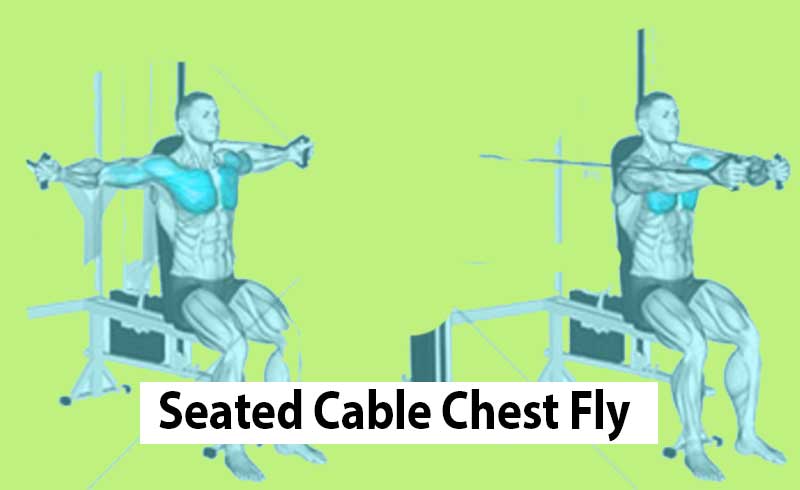The Seated Cable Fly is one of the incredible cable chest exercises that targets the often overlooked muscles of your upper chest, helping you achieve a well-rounded and sculpted chest and shoulders.
In this exercise guide, we’ll dive covering:
- What is the Seated Cable Chest Fly, and why is it worth incorporating into your routine?
- Muscles worked during the Seated Cable Fly
- Step-by-step instructions on how to perform it exercise correctly, along with some tips to boost your results.
- Common mistakes to avoid, ensuring you get the most out of every rep.
What Is Seated Cable Fly
The “Seated Cable Pec Fly” is an exercise that targets the pectoral muscles, which are the muscles of the chest. It is called a “fly” because the motion of bringing the handles together in front of your chest resembles the flapping wings of a bird.
The exercise is performed using a cable machine, which provides constant resistance throughout the movement.
It’s a valuable exercise for building a strong and well-defined chest, especially for people interested in bodybuilding and overall upper body strength.
Similar Workout: How To Do Machine Chest Fly For Bigger Pec?
Seated Cable Chest Fly Muscle Worked
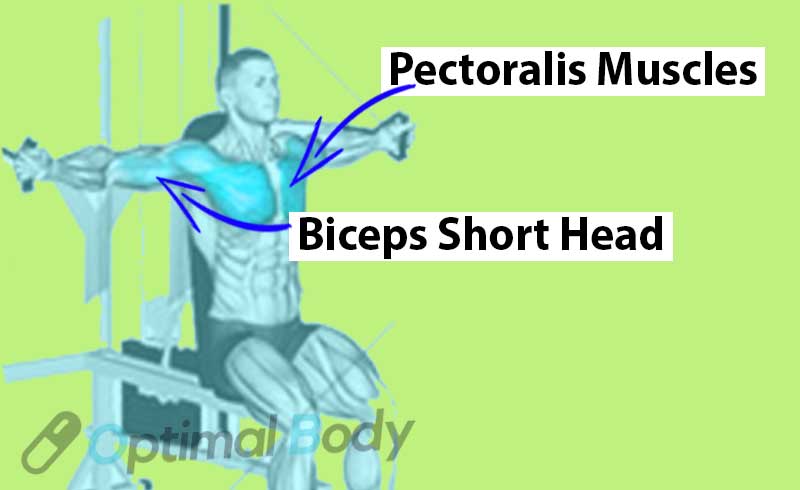
The Seated Cable Fly primarily targets the chest muscles, specifically the pectoralis major, which are the main muscles of the chest.
Secondary muscles that also get engaged to support the movement include the anterior deltoids (front shoulder muscles) and the triceps (back of the upper arm).
While the main focus is on the chest, these secondary muscles play a role in assisting and stabilizing the movement.
Seated Cable Chest Fly benefits
The Seated Cable Chest Fly exercise offers several benefits for individuals looking to strengthen their chest muscles and improve overall upper body strength.
Here are the key advantages:
- Targeted Chest Development: The primary benefit of the Seated Cable Pec Fly is its ability to target and isolate the pectoral muscles (chest muscles). This exercise effectively engages the chest, helping to build strength and muscle mass in this area.
- Constant Resistance: The cable machine provides constant resistance throughout the entire range of motion, ensuring that the chest muscles are consistently engaged. This steady resistance can lead to better muscle development and growth over time.
- Balanced Muscle Development: The Seated Cable Pec Fly allows for controlled movements, helping to ensure both sides of the chest receive equal attention and stimulation.
- Variation in Chest Workouts: Including the Seated Cable Pec Fly in your workout routine adds variety to your chest exercises. It complements other chest movements like bench presses and push-ups, providing a well-rounded approach to chest training.
- Reduced Joint Strain: The seated position and controlled motion of the exercise can help reduce strain on the shoulder joints compared to certain free-weight chest exercises. This makes it a suitable option for individuals with shoulder issues or those who want to minimize joint stress.
- Improved Upper Body Strength: Strengthening the pectoral muscles can enhance overall upper body strength, benefiting various daily activities and sports performance.
- Suitable for Different Levels: This exercise can be adjusted to accommodate different fitness levels by adjusting the weight or resistance on the cable machine.
- Enhanced Muscle Control: The controlled nature of the Seated Cable Fly requires focus and stability, promoting better muscle control and coordination.
For optimal results and safety, perform this exercise with proper form and within your physical capabilities.
How to do the Seated Cable Pec Fly: + Video Guide
Step 1: Sit on the bench and hold the cables with handles in front of your chest
Find a bench or seat with back support and sit down. Grab the handles attached to the cables so that your arms are extended out in front of your chest. Your palms should be facing down.
Step 2: Stretch your arms out wide, feeling a nice stretch in your chest muscles
Start by moving your arms outward, away from each other. This motion will stretch your chest muscles, and you should feel a gentle pulling sensation across your chest.
Step 3: Bend your arms slightly and bring the handles together in front of your chest
After stretching your arms out, bend your elbows a little and pull the handles toward each other in front of your chest.
As you do this, focus on squeezing your chest muscles together. Imagine you are hugging a big ball.
This squeezing action helps to strengthen and build your chest.
You can also cross your hands over the center to get an even better chest contraction
If you want a deeper muscle contraction, you can cross one hand over the other while bringing the handles together.
Step 3: When you bring the handles together, hold that position for a brief moment and really contract your chest muscles
Step4: Breathe in as you relax your arms and breathe out as you contract your chest muscles
As you bring the handles together and squeeze your chest, breathe out steadily. Controlling your breathing helps you stay focused and maintain the right form.
By following these steps and practicing the Cable Seated Fly regularly, you can effectively target and strengthen your chest muscles.
Exercise Tips:
- Always keep your arms slightly bent to protect your shoulder joint during the exercise
- Avoid locking your arms out completely, as this can put unnecessary stress on your shoulder joints.
- Keep your head in a comfortable position, looking straight ahead. This helps maintain proper alignment and reduces the risk of straining your neck.
Mistakes To Avoid
When performing Seated Cable Flyes, it’s crucial to be mindful of common mistakes that can hinder your progress and increase the risk of injury:
- Using excessive weight: Use an appropriate weight to maintain proper form and muscle engagement.
- Limited full range of motion: Perform a complete range of motion, stretching your arms wide and bringing the handles together for a full contraction.
- Rounding the shoulders: Keep your shoulders back and down to avoid strain and keep the focus on the chest muscles.
- Locking out the elbows: Maintain a slight bend in your elbows throughout the movement to reduce shoulder joint strain.
- Lifting the hips off the bench: Keep your hips firmly on the bench to ensure stability and proper form.
- Using momentum: Avoid using momentum or swinging the weight, instead opting for controlled and steady movements.
- Neglecting the mind-muscle connection: Establish a strong mind-muscle connection to target and engage the chest muscles effectively.
- Overarching the lower back: Avoid excessive arching of the lower back by engaging your core muscles for stability.
- Performing the exercise too quickly: Perform the exercise at a controlled pace, as slower movements are more effective in engaging the muscles.
Best Alternatives To Seated Cable Flyes
1. Incline Cable Flyes
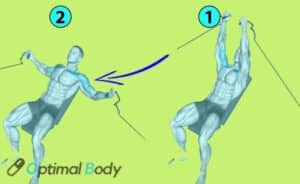
Performing the Cable Flyes on an inclined bench changes the angle of the movement, placing more emphasis on the upper chest muscles.
This variation helps create a well-rounded and balanced chest development.
2. One-Arm Seated Cable Flyes
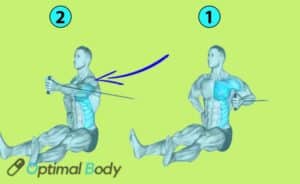
Performing the exercise one arm at a time allows you to concentrate on each side individually.
It helps to correct any strength imbalances between the left and right sides of the chest, leading to more symmetrical muscle development.
3. Standing Cable Crossovers
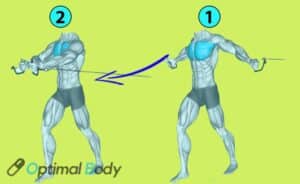
By doing the cable crossovers in a standing position, you engage your core for stability and activate additional stabilizer muscles in the chest and shoulders.
This variation also allows for a more extensive range of motion, leading to increased muscle recruitment.
4. Seated Chest Fly Machine
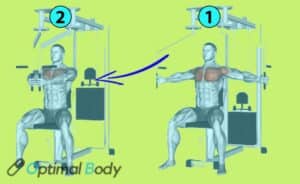
The Seated Fly Machine involves sitting on a machine with padded handles or levers that are pulled together in front of the chest, simulating a fly-like movement.
This exercise helps strengthen and tone the upper body, particularly the chest, shoulders, and arms, providing an excellent alternative to traditional free-weight exercises for chest development.
Cable Seated Chest Fly Alternate
- Cuffed Seated Cable Fly
- One Arm Cuffed Seated Cable Chest Fly
- Seated Cable Lower Chest Fly
- Seated Cable High Chest Fly
Standing Cable Fly Vs Seated: Whis One Is Better?
The choice between seated cable fly and standing cable fly depends on your specific fitness goals, preferences, and individual circumstances.
Both exercises have their advantages and can be effective in targeting different muscles and aspects of your chest and shoulder development.
Seated Cable Fly
- Stability: The seated position provides more stability, making it easier to maintain proper form throughout the movement.
- Isolation: It allows for better isolation of the chest muscles since you’re not using your lower body for balance.
- Focus on Upper Chest: Seated cable fly primarily targets the upper chest, which is beneficial if your goal is to develop this area.
- Lower Back Relief: If you have lower back issues, the seated position can alleviate strain during the exercise.
Standing Cable Fly
- Core Engagement: The standing position requires more core engagement for stability, making it a good option for those looking to work their core while targeting the chest.
- Overall Balance and Coordination: Standing cable fly challenges your balance and coordination, engaging more stabilizer muscles.
- Pectoralis Minor Activation: It may engage the pectoralis minor to a greater extent, contributing to a fuller chest appearance.
- Variety of Angles: You can adjust the cable height and body positioning to target different parts of the chest and shoulders.
Both seated and standing cable fly variations can be valuable additions to your gym workout routine.
If you want to focus on isolating the upper chest with added stability, the seated cable fly may be preferable.
On the other hand, if you seek more overall engagement and core activation, the standing cable fly could be a suitable choice.
References and Sources:
- Oliveira CB, Negrão Filho RF, Franco MR, Morelhão PK, Araujo AC, Pinto RZ. Psychometric Properties of the Deep Muscle Contraction Scale for Assessment of the Drawing-in Maneuver in Patients With Chronic Nonspecific Low Back Pain. J Orthop Sports Phys Ther. 2017 Jun;47(6):432-441. doi: 10.2519/jospt.2017.7140. Epub 2017 May 13. PMID: 28504068.
- https://www.betterhealth.vic.gov.au/health/healthyliving/breathing-problems-and-exercise
- https://pubs.nmsu.edu/_i/I111/
- Escalante, Guillermo. (2016). Exercise Modification Strategies to Prevent and Train Around Shoulder Pain. Strength and Conditioning Journal. 39. 1. 10.1519/SSC.0000000000000259.
- Bench Press Calculator - April 22, 2024
- Press to Handstand: Ultimate Step-by-Step Guide - April 22, 2024
- Cable Press (How To Do, Benefits, Targeted Muscles, Alternative) - April 22, 2024

